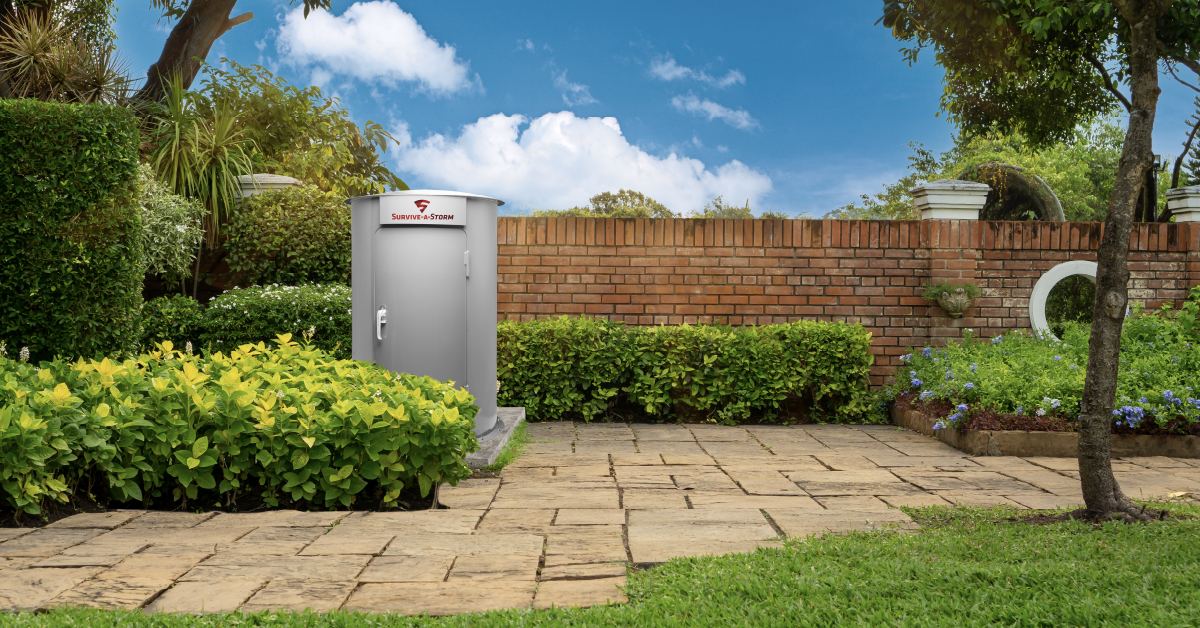CATEGORIES:
When Installing an Above-Ground Residential Tornado Shelter Makes Sense
January 18, 2024

Tornadoes are unpredictable and if you’re not prepared the results could be devastating - injuries to you and your family, or even death. The best way to stay safe during a tornado is inside a tornado shelter.
Installing a tornado shelter at your home requires a lot of consideration and careful planning. We’ve covered the intricacies of installing underground shelters on our blog. This article will delve into the installation of above-ground tornado shelters. We’ve got the knowledge to give you the confidence needed for a successful and secure installation.
Why Select an Above-Ground Tornado Shelter?
There are many reasons to select an above-ground tornado shelter. You may simply value preparedness, and know that it’s an easy and cost-effective solution. But understanding a few other advantages and considerations is also essential.
Above-ground tornado shelters, when built to the right specifications, are a reliable and effective solution. They’re built with reinforced steel and anchored to thick concrete slabs, providing many pounds of resistance against the force of a tornado. To ensure optimum protection, look for shelters like those from Survive-A-Storm which are built to the specifications of the National Storm Shelter Association.
For most people, an above-ground shelter makes more sense than its underground equivalent. For example, if you reside in a region prone to tornadoes, but also an area that is flood-prone or has a high water table. Being in an underground shelter during a flood could be a recipe for disaster. Imagine trying to exit the shelter once the area above it is flooded.
Another consideration that makes an above-ground shelter a better preference is accessibility. For those with disabilities or when navigating stairs is a challenge, a solution that is ground level and can be accessed quickly, makes much more sense.
And still, there are other people who may not own the property that they live on. They can add an above-ground shelter to a concrete slab with little modification to the existing property, and it can even be moved and re-installed should the owner of the shelter move locations.
Pre-Installation Considerations for a Tornado Shelter
To install an above-ground tornado shelter, you need only have access to a concrete slab of a specific size and thickness, depending on the model of tornado shelter. This can even be planned during pre-construction if a homeowner is building a new home, allowing the shelter to go inside the home. Alternately, they can also be placed close to the exterior of the home or inside of a garage or outbuilding. Survive-A-Storm offers a number of great options when it comes to above-ground tornado shelters:
Site Preparation for an Above-Ground Storm Shelter
If being placed on the exterior of the home, preparing the site will involve clearing debris, ensuring the ground is level, and measuring the area accurately. This step is vital for the stability of the shelter. Choosing the right spot for your shelter is crucial. It’s important to be sure that the area is easy to access since the installation will involve moving a shelter that weighs 1000+ pounds from the curb to the installation site. It should be equally as accessible during an emergency, so you’ll need to consider factors like ground stability and proximity to your home.
Above-Ground Tornado Shelter Installation Process
Above-ground tornado shelters from Survive-A-Storm are installed by our expert installers. However, for those who prefer to do it themselves, a detailed step-by-step instruction process can be sent after the purchase of the shelter is complete. This includes anchoring the shelter properly to withstand high winds, and ensuring the door is easily accessible.
Once installed, you’ll want to outfit your shelter with emergency supplies, and make sure that everyone in the home is familiar with how and when to access the shelter. Make sure they understand where the vents and escape hatch are, and how to get any pets inside, plus themselves! Preparation like this can make a significant difference in an emergency.
Maintenance and Inspection
If you’ve done a self-installation, you’ll need to provide photos after the installation is complete for warranty purposes.
Above-ground shelters are mostly maintenance-free, but it’s a good idea to inspect the shelter annually. This includes checking for rust, door integrity, and anchoring stability. And again, to maintain the warranty, you’ll send yearly photos of the inside and outside of the shelter to Survive-A-Storm.
Lastly, but still very important, each year review with your family how to access and use the shelter. These steps are a good way to ensure shelter remains safe and accessible.
An above-ground tornado shelter is a vital investment in areas prone to severe weather. The peace of mind it offers is invaluable. To consider an above ground shelter for your home, contact Survive-A-Storm Shelters today.




